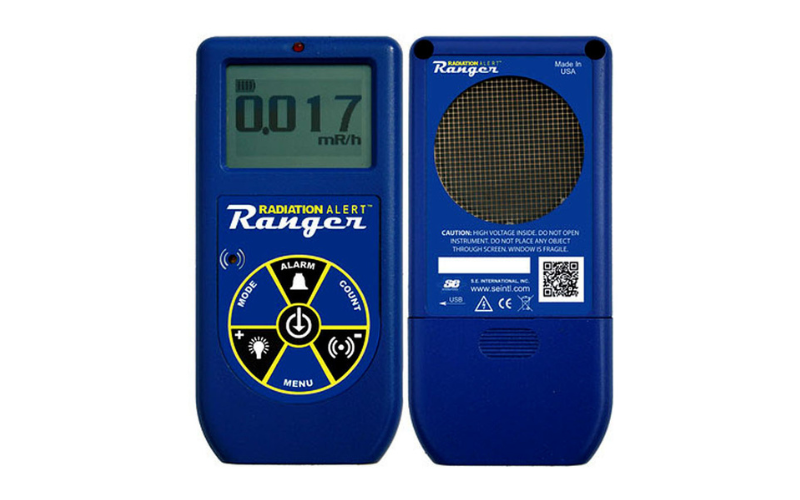Articles
Steps to Follow After High Levels of Radiation Have Been Detected
Posted on March 28, 2023

In large part, the correct response to a radiation event depends on two factors. There are things an employee can do to detect an event involving high levels of radiation and the steps the organization might need to take. Role in the organization is one thing then. The other variable is the location of the event.
This blog only concerns the normal radiation events that happen in mining, security, research, transportation, and manufacturing. Your organization may need or want a record of the type and amount of radiation involved in everyday operations or in a radiation-related emergency. A variety of devices, like the Radiation Alert Ranger, provide the needed capabilities to both detect radiation and characterize it. S.E. International offers this and many other radiation monitoring and detection tools.
Radiation Alert Ranger Features Relevant to Radiation Accidents
This is a handheld detector that has these key features:
• A user can detect radiation and measure alpha, beta, gamma, and x-ray emissions.
• Users can tag readings with GPS data and generate reports on counts per hour, counts per second, total counts, millisieverts, or rads.
• These data points can all be exported using the included USB connector and studied in S.E. International’s free Observer software. This device also supports Bluetooth with an optional adaptor.
Use the Radiation Alert Ranger for contamination surveys, screening, and regular inspections. The Ranger or a similar device will prove useful in identifying and responding to a variety of radiation-related problems.
The nature of the possible events and the type of radiation encountered vary widely from one setting to another. A nuclear research facility is unlikely to contaminate groundwater or soil, while a mining operation that processes radioactive ore is likely to contaminate air and soil while also exposing workers if something goes wrong. Regardless of the nature or severity of the radiation event, high levels of radiation need to be recorded and reported.
Any research center or business that deals with radioactive materials needs to be able to characterize the amount and type of radiation involved. S.E. International offers a range of devices for different working environments and software for sharing and tracking historical radiation exposure information. However, the nature of the business and likely radiation accidents or events largely determines the type of radiation detection needed.
Types of Events and Risks
Contamination and exposure are two consequences of accidental radiation exposure, and they both must be handled differently in terms of radiation detection gear used and response measures. Workers may be exposed to radioactive emissions in the form of x-rays, beta rays, gamma rays, or neutrons, though exposure to that last source is probably quite rare.
The nature of the risk people face from radiation exposure depends on intensity, duration, and type. Radioactive emissions come in two varieties – ionizing, which is energetic enough to strip electrons from atoms, and nonionizing, which is not. Radiation may come in the form of high-energy neutrons, alpha particles, beta particles, x-rays, and gamma rays.
Be aware of likely radiation sources your work may expose your employees to and radiation detection gear can minimize the risk of a serious radiation exposure event. You also need to characterize the amount of radiation in the environment and track that over time, both to detect a major problem and to protect employees and the public.
Responding to a Radiation Event
Once you detect radiation outside the expected range, this is a radiation event. The correct response will depend on the setting and the nature of the event. Government regulations and related company policies should be the main sources of guidance on what to do, how, and when. Some government agencies also publish guidelines. For example, the Occupational Safety and Health Administration has some guidelines on dealing with radiation-related emergencies.
The single most important thing employees and management can do is to be sure they are familiar with company procedures related to excessive radiation exposure. Whether contained in those policies or not, certain government regulations may apply. Be sure to know and follow any relevant rules on clean-up or reporting.
The organization may need to monitor exposed employees’ health because the signs of radiation exposure can take time to appear even after they encounter high levels of radiation. Tumors connected to a serious radiation event will naturally take even longer to develop.
Use the Right Radiation Detector to Improve Response
Radiation events that release high levels of radiation can occur for assorted reasons and may cause exposure or contamination, or both. Evaluating the scale of the problem and taking the right action is much easier with a flexible tool like Radiation Alert Ranger monitor and using the including or optional reporting functions. You can count on S.E. International to provide radiation detection hardware, radiation monitors, and radiation monitoring software along with NIST calibration services to keep your equipment compliant. Contact us to learn more.
Leave a Reply
Your email address will not be published. Required fields are marked *